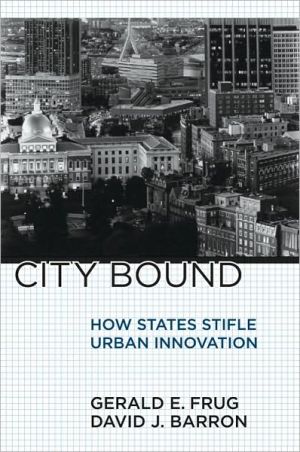

 |

|

The average rating for City Bound: How States Stifle Urban Innovation based on 2 reviews is 4 stars.
Review # 1 was written on 2013-09-15 00:00:00 Juan Franco Juan FrancoIt is vital to the realization of city 2.0 that city planners understand how state law limits city power. As Gerald Frug and David Barron, two professors at Harvard Law, put it, "The importance of this starting point is regularly overlooked by analysts of city power, as well as by those who call for regional policies even though there is no regional authority empowered to adopt them." But with their 2008 book, City Bound: How States Stifle Urban Innovation, Frug and Barron have created an accessible introduction to the state-created limits on city power and a handbook to how states and cities can encourage innovation within that framework. "By framing city power in the right way," they argue, "states can do more to address urban issues, both local and regional, than is currently thought possible." I like their approach because it's pragmatic; indeed, you could even call it data-driven. To develop their theory of how to frame city power, they analyze and discuss the legal framework of seven major American cities: Atlanta, Boston, Chicago, Denver, New York, San Francisco, and Seattle. In the end, they recognize that some state constraints on city authority are necessary but that, at the same time, cities must be given power to innovate to key areas. These points are best illustrated, in my mind, by two examples. First, why state constraints can be bad: when NYC tried to impose congestion charges on city traffic in 2007, the city asked the state for permission, but the state set up a needless bureaucracy to study the proposal, hindering innovation. Yet on the other hand, some state constraints are necessary: for example, eco-friendly cities cannot control their air-polluting neighbors, making it necessary for the state to pass statewide air-quality regulations. From their study, Frug and Barron derive a vision of four "city futures" (which, they point out, are not mutually exclusive): 1. A global city'seeking to stake an important place in the global economy 2. A tourist city'seeking to develop rich placemaking to attract visitors 3. A middle-class city'seeking to provide services to citizens, especially education 4. A regional city'seeking to enhance relationship with surrounding communities They then argue that the now-prevailing legal framework in most states makes it easier for major cities to pursue being a global or tourist city, rather than a middle-class or regional city. States should restructure these frameworks, they propose, to give the cities more control over land use, revenues and expenditures, and regional cooperation. They emphasize that these limits, correctable through political will, are easier to change than geographic, social, or economic limitations. Aside from these observations, however, the book is a bit light on specific, concrete recommendations for cities. The authors are more interested in examining the contours of their proposed city futures than suggesting specific goals for cities to pursue. But the authors description of the limitations of city power is so detailed that the things that need to change are self-evident, especially in regard to city control over land use, education, and revenues and expenditures (though many of their observations are Boston-centric). And they do a good job fulfilling their stated goals of re-igniting a discussion of state-defined legal limits on city power and highlighting how those limits are usually overlooked by city-planning theorists. And this discussion is vital: If cities are to be the innovation centers of the future, city planners must be acutely aware of the legal framework in which they are operate, and the obstacles they face in creating the cities of tomorrow. |
Review # 2 was written on 2013-08-13 00:00:00 Thomas Archbold Thomas ArchboldPreface + "Tasting Wisconsin" and the chapter on Vermont. ~ Introduction is a little rough (scattered connections) but continuity improves while describing local impressions. |
CAN'T FIND WHAT YOU'RE LOOKING FOR? CLICK HERE!!!